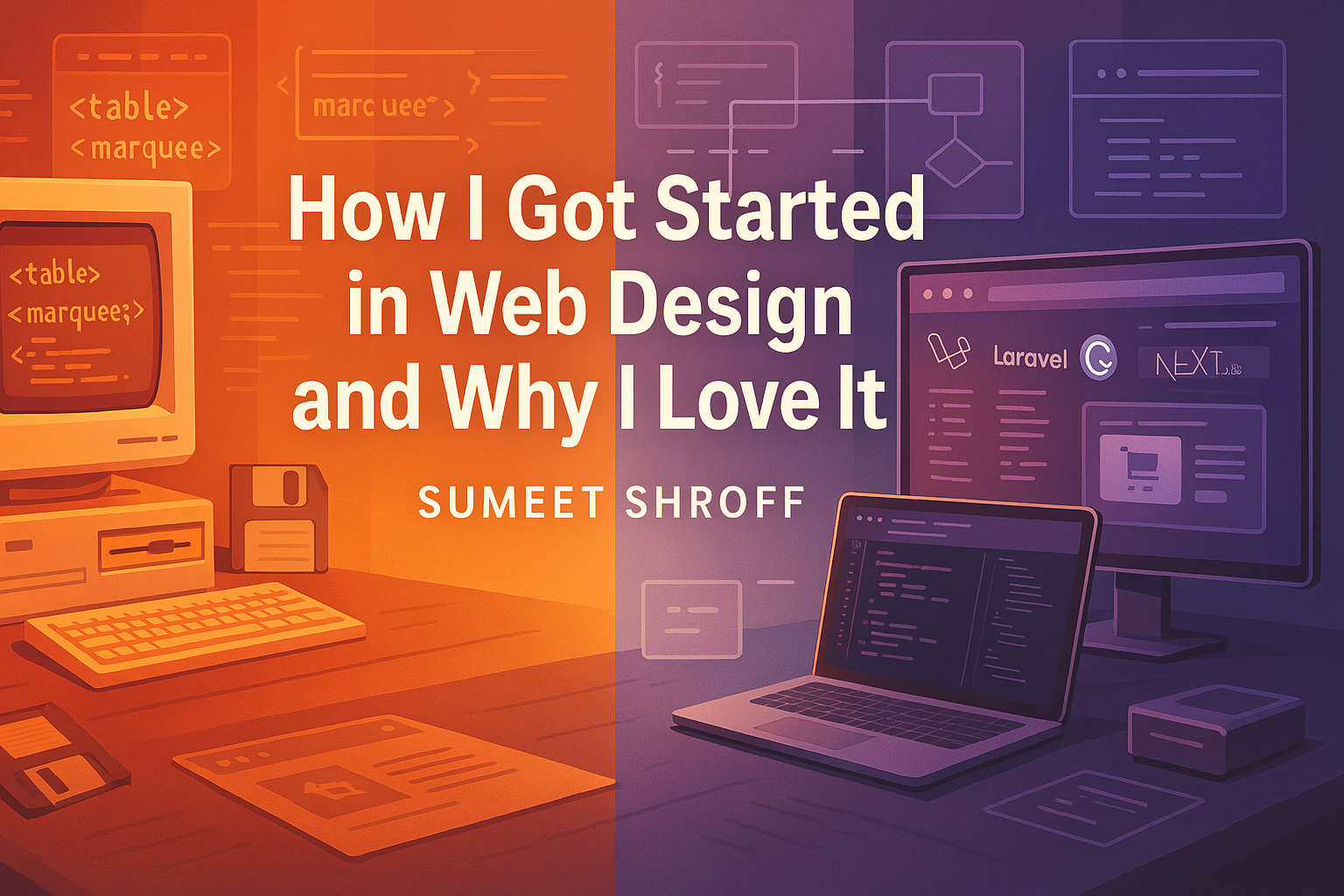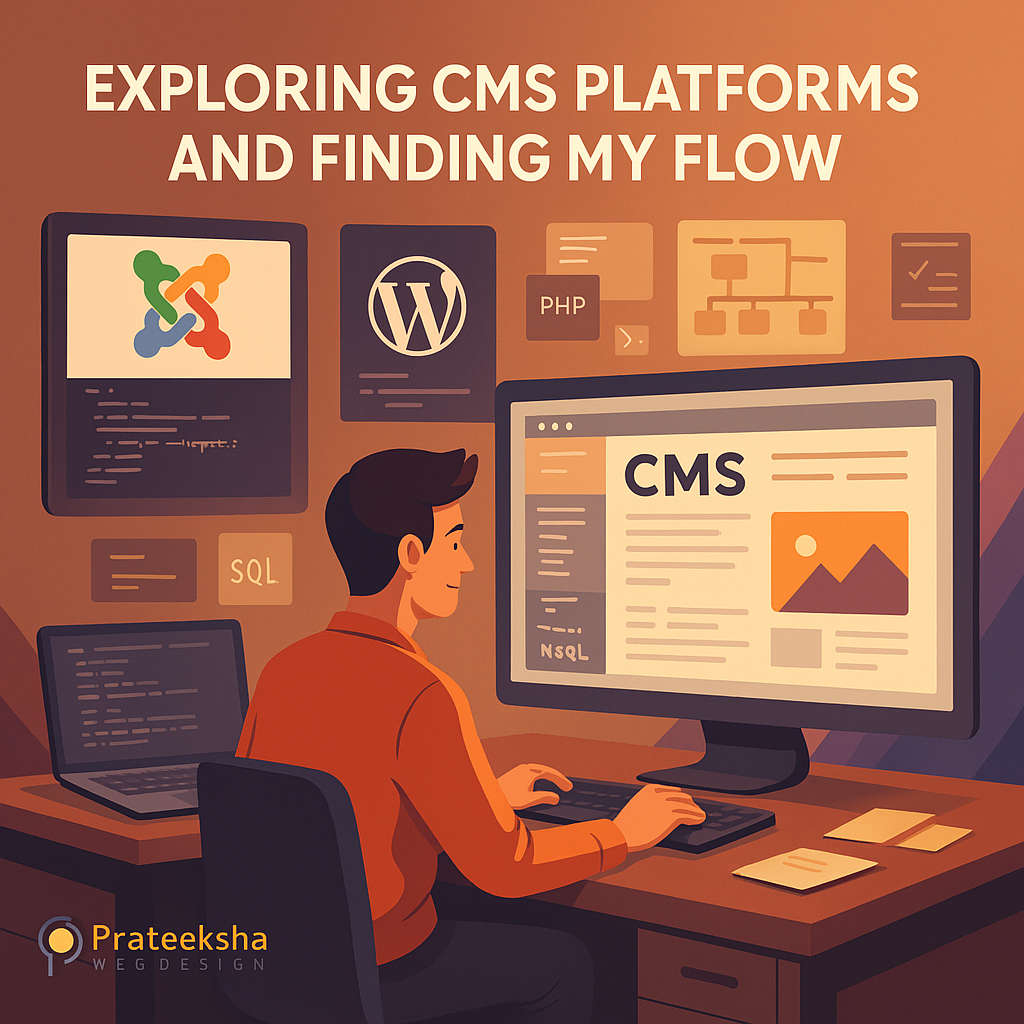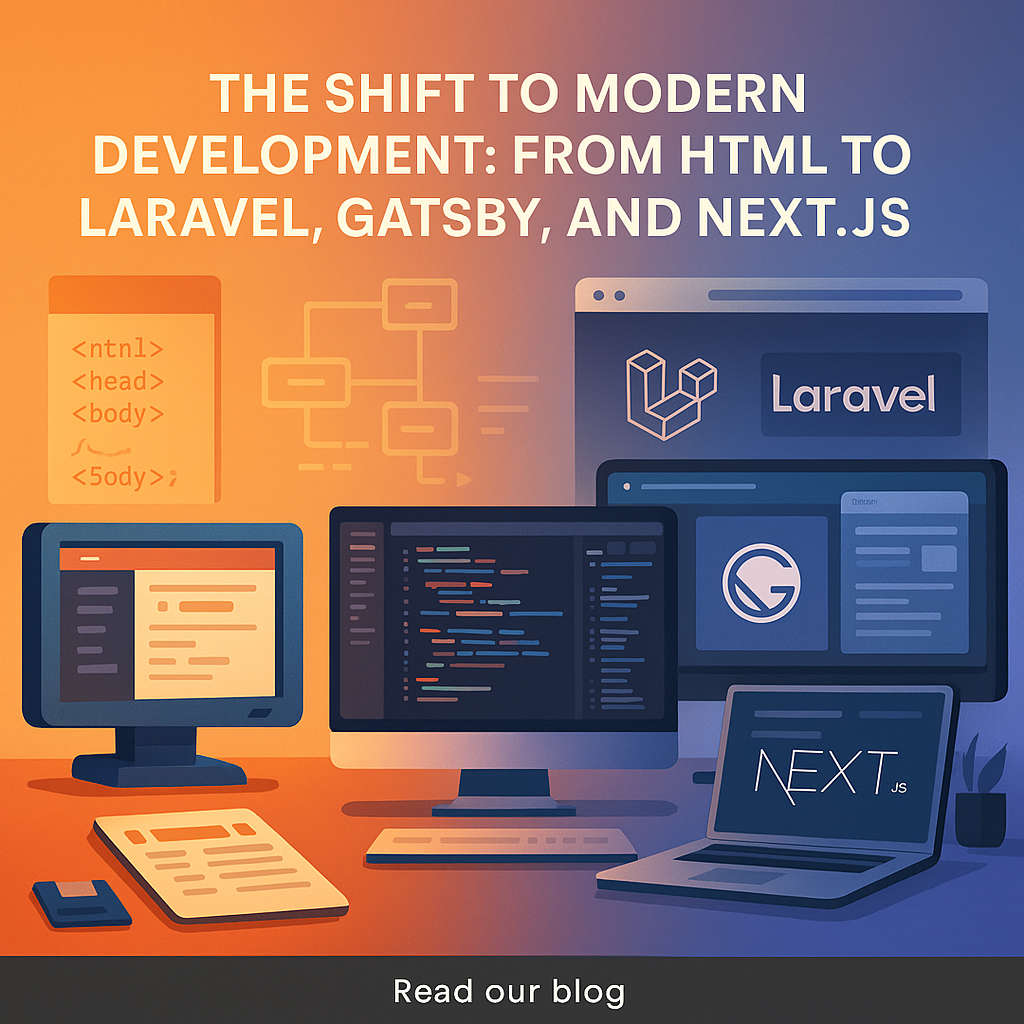How I Got Started in Web Design and Why I Love It

It all started in 1997.
Back then, the internet was still a frontier—slow, pixelated, and full of possibilities. I was in high school, curious and constantly tinkering with anything that had a screen. One day, I stumbled upon an old HTML tutorial on a CD-ROM (remember those?) and decided to try building my own web page. It was nothing fancy—just a basic page with some blinking text and a background color that would make your eyes hurt today. But something about writing code, hitting “refresh,” and instantly seeing the result sparked something in me. I was hooked.
From CGI Scripts to Dreamweaver Days: The Early Days of My Web Design Journey
My web design journey began in the late 90s, when the internet felt like a digital Wild West—raw, experimental, and full of untapped potential. My first hands-on experience came through building static HTML websites paired with CGI scripts for simple forms. I still remember the thrill of seeing a contact form actually submit data using Perl. At the time, it felt like I had unlocked a superpower.
This was before YouTube tutorials or Stack Overflow—debugging CGI scripts meant endless hours on developer forums, deciphering cryptic error messages, and experimenting through trial and error. That process was hard, but it sharpened my skills and ignited a lifelong curiosity. It was the first time I truly felt what it meant to be a full stack developer, working both on the front end and back end—even if my back end was just a Perl script that sent an email.
As I grew more comfortable writing code, tools like Macromedia Dreamweaver completely changed the game for me. Dreamweaver introduced a new way of building websites visually while still giving access to raw HTML and CSS. It felt revolutionary at the time and gave me more control over layout and structure.
But I didn’t stop there. To level up my skills, I dived into Adobe Photoshop and Illustrator, learning how to design user interfaces, create custom graphics, and build websites that didn’t just function—they looked sharp and professional. That was my first big leap from being just a coder to becoming a web designer with marketing skills—someone who could not only build a site but make sure it visually aligned with a brand and business goals.
This early phase in my learning web development taught me more than code. It taught me how to solve problems, adapt to new tools, and approach design with intention and purpose. These foundational skills continue to guide my work even today.

Exploring CMS Platforms and Finding My Flow as a CMS Builder
By the mid-2000s, my toolkit had evolved. I was building dynamic websites using PHP and MySQL, diving deeper into backend logic and relational databases. That’s when I discovered platforms like WordPress and Joomla, which introduced me to the world of content management systems.
Joomla caught my eye early on because of its flexibility and modular structure. It allowed me to create more complex websites for clients who needed more than just a blog. WordPress, on the other hand, stood out for its simplicity and user-friendliness—perfect for small businesses that wanted to manage their own content. I became proficient with both, customizing themes, extending functionality with plugins, and offering complete website solutions to local businesses and friends launching new ventures.
But I wanted more control. I was growing into a CMS builder, and the limitations of pre-built systems began to feel constraining. That’s when I took on one of my most ambitious challenges—I built my own CMS from scratch.
Using PHP and MySQL, I created a lightweight, flexible content management system tailored to my clients' unique needs. Building a CMS from the ground up gave me deep insight into how content is stored, delivered, and managed. It also helped me master user authentication, WYSIWYG editors, image handling, and admin dashboards—things I’d taken for granted in Joomla or WordPress.
More importantly, it shifted how I approached projects. I began thinking like a product architect, not just a developer. I started designing systems that prioritized user experience, speed, and simplicity—key ingredients for websites that perform well. These lessons would later serve me as I transitioned into more modern stacks like Laravel and Next.js.
This era solidified my role as a full stack developer—someone equally confident designing an interface, writing business logic, and ensuring databases were optimized. It also taught me to approach web development holistically, blending creativity, logic, and business strategy.
By focusing on real-world problems and building solutions from scratch, I gained the confidence to eventually offer full-service web development. From eCommerce web development to SaaS app development, I wasn’t just building websites—I was building digital ecosystems that helped businesses grow.

The Shift to Modern Development: From HTML to Laravel, Gatsby, and Next.js
As the landscape of web development transformed, I knew I had to evolve with it. My web design journey had taken me from hand-coded HTML to custom-built CMS platforms—but I wasn’t done growing. I wanted to streamline my workflow, write cleaner code, and build more powerful and scalable applications. That’s when I discovered Laravel.
Learning Laravel was like discovering a new language that spoke directly to developers. Its elegant syntax, MVC structure, and out-of-the-box features made back-end development feel intuitive and professional. For the first time, I felt like I could build robust applications without having to cobble together a dozen different libraries. Laravel offered a modern, expressive way to handle everything from routing and middleware to authentication and RESTful APIs. It marked a pivotal moment in my evolution—from a PHP developer to a full stack developer with a refined toolkit.
While Laravel handled the server-side beautifully, I began exploring more advanced front-end frameworks to meet modern performance and UX standards. That’s when I dove into Gatsby, a React-based static site generator that redefined how I built websites. Gatsby gave me the speed and security of static websites, along with the flexibility to pull data from APIs, CMSs, or markdown files. It was perfect for building fast, SEO-friendly marketing sites with smooth animations and modern design aesthetics.
But it was Next.js that truly changed the game.
As a Next.js developer, I gained the power of hybrid rendering—combining static site generation (SSG), server-side rendering (SSR), and client-side rendering in a single framework. With built-in API routes, image optimization, and seamless routing, Next.js allowed me to build high-performance websites and full-scale SaaS applications that were both scalable and user-centric.
Whether it was a blazing-fast landing page, an eCommerce web development project, or a data-rich dashboard, I could now create custom digital experiences with unmatched performance and developer efficiency.
These modern tools elevated my capabilities. I was no longer just building websites—I was crafting full-stack solutions that integrated content, functionality, speed, and SEO best practices. And because I had experience across the spectrum—from legacy systems to cutting-edge frameworks—I knew how to choose the right tool for each client’s unique goals.
This transition also enabled me to expand into full-service web development, where I could seamlessly combine:
- Front-end design and performance optimization
- Backend development using Laravel
- Custom API integration
- SEO and digital marketing integration
- Web applications and SaaS platforms built on Next.js
Unlike many developers who specialize in only one area, I bring a blend of skills that connect the dots between design, development, and marketing. I understand that a website isn’t just a digital brochure—it’s a living, breathing extension of your brand, built to convert, engage, and grow with your audience.
This modern stack—from HTML to Laravel, Gatsby, and Next.js—represents not just my technical growth, but my passion for staying at the forefront of the web. It’s what enables me to deliver results that are not just functional, but strategic and future-ready.
Whether you’re just learning web development, looking for a web designer with marketing skills, or searching for someone to build your next SaaS app, my journey proves that adaptability, curiosity, and craftsmanship never go out of style.
From Hobby to Full-Service Business
As I mastered design and development, my role naturally shifted. Clients didn’t just want a website—they needed a solution. They wanted strategy, performance, conversions, and growth. That’s when I began expanding my services and building a full-stack offering.
Today, I provide comprehensive digital solutions, including:
✅ Website Design
From wireframes to polished UI/UX, I craft websites that tell a brand’s story while delivering intuitive navigation and stunning visuals. My design work doesn’t just look good—it drives action.
✅ eCommerce Website Development
Whether it’s Shopify, WooCommerce, or a custom Laravel + Vue/React stack, I help businesses sell smarter. I build online stores that are fast, secure, and conversion-optimized.
✅ SaaS Application Development
For startups and tech-driven businesses, I develop full-fledged SaaS platforms using Laravel, Next.js, and cloud-native infrastructure. From MVP to scale-up, I handle both back-end logic and front-end finesse.
✅ Mobile App Development
I develop cross-platform mobile apps with tools like React Native and Flutter, helping clients launch apps that feel native, perform smoothly, and connect seamlessly to their web platforms.
✅ SEO and Digital Marketing
Because a great website alone isn’t enough. I combine technical SEO, on-page optimization, and digital marketing strategy to help clients get found, get traffic, and get results.
Why My Approach Is Different
I often say, "You don’t need a website—you need a solution."
Most agencies silo design, development, and marketing. But I’ve always believed in integrating all three. My projects start with business goals, not templates. I ask questions like:
- What do you want your visitors to do?
- What value are you offering them?
- How will we measure success?
Because I understand design and code and marketing, I’m able to build solutions that are not just beautiful, but functional and optimized for results.
Clients love that I can handle it all—from sketching a concept, coding the back-end, optimizing the front-end, launching the campaign, and scaling the application.
I’ve worked with everyone from solo entrepreneurs to agencies and mid-sized companies. Every project is an opportunity to combine creativity with logic, art with engineering, and vision with execution.
Reflecting on the Journey
Looking back, I never imagined that a blinking-text webpage in 1997 would lead me here. But I’m glad it did.
What keeps me passionate isn’t just the code or the design tools—it’s the people. It’s the excitement of a client seeing their new brand come alive online. It’s helping a small business double their online sales. It’s building something from scratch that goes on to serve thousands of users.
Every project still feels like a puzzle, a challenge, and an opportunity to learn something new. The tech evolves, the trends change, but the core remains the same: creating meaningful digital experiences that drive results.
Let’s Build Something Together
If you’re looking for a designer-developer who understands business, who can guide your project from idea to impact, and who’s been in the game since dial-up—then let’s talk.
Whether you need a custom website, an eCommerce store, a mobile app, or a SaaS platform, I’m here to help you build it right—with strategy, care, and results.
👉 Reach out to discuss your project
👉 Or explore my services here
Thanks for reading my story. I’d love to hear yours.
